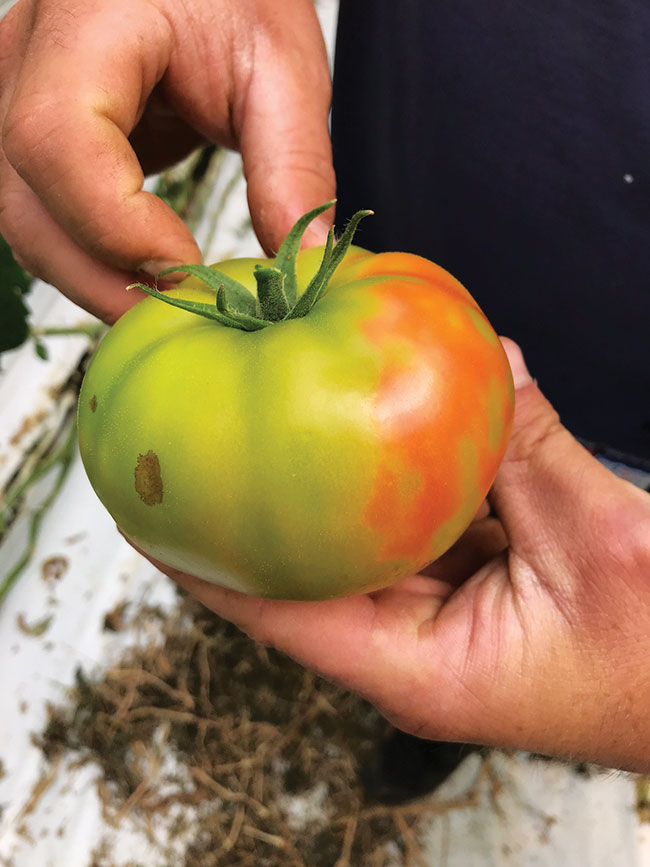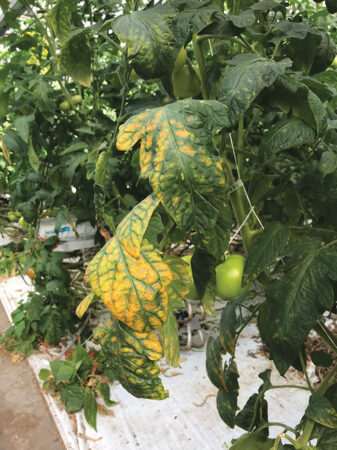
Features
Diseases
ToBRFV impact and efforts to breed immune plants
The virus’s effects on plant health, appearance and a grower’s bottom line make it a nuisance to watch for.
March 8, 2023 By Steph Coelho
 Photos courtesy of OMAFRA.
Photos courtesy of OMAFRA. Around the same time as COVID-19 was creeping into North America, another virus was making its way overseas. First identified in Israel in 2014, tomato brown rugose fruit virus (ToBRFV) has since infected tomato plants worldwide.
According to Statistics Canada, Canadian field and greenhouse farmers produced 798,970 tonnes of tomatoes in 2020, representing a value of over $700 million. Ontario is by far the largest producer of greenhouse tomatoes in Canada, producing an output nearly five times that of British Columbia and almost eight times more than Quebec. And a significant portion of Canada’s tomatoes, 151.3 million kilograms in 2020 alone, are exported to the United States.
Travis Banks, director of plant variety development with the Vineland Research and Innovation Centre, says that, while ToBRFV doesn’t represent a risk to human health or food security, it impacts plant health and aesthetics, which can harm a producer’s bottom line in myriad ways.
ToBRFV’s impact on crops
ToBRFV is capable of infecting solanaceous plants like tomatoes, peppers and eggplants. However, Amanda Tracey, Ontario Ministry of Agriculture, Food and Rural Affairs (OMAFRA) vegetable crop specialist, says that tobamovirus resistance seems to be holding in peppers at the moment, and greenhouse peppers have yet to be affected by the virus. Tracey does note she can only speak to the context in Ontario.
In tomato plants, ToBRFV produces visible symptoms such as fruit discoloration and mottling, which can look like other diseases or plant problems. Some plants may not even show signs of illness.
Ultimately, it’s impossible to definitively diagnose ToBRFV without a lab test, which can make controlling the spread challenging.
Visual signs of the disease on fruit can also impact market value. Consumers are less likely to purchase imperfect produce, and retailers aren’t likely to stock items people aren’t interested in purchasing.
And ToBRFV doesn’t just affect plant aesthetics. “The virus impacts the plant in a pretty negative way. A virus-infected plant will produce less tomatoes,” says Banks.
Border restrictions and other roadblocks
Because of crop losses and the virus’s impact on market value, producers in Ontario have seen increased costs due to biosecurity, preventative techniques, sanitation protocols, and replanting needs, says Tracey. There’s also a need to educate employees about new protocols, which can involve an investment of both time and money.
Tracey also says that increased border inspections of tomato and pepper transplants, fruit and seed lots, due to the 2019 Animal and Plant Health Inspection Service (APHIS) Federal Order in the U.S., represent a burden for both field and greenhouse growers.
Whether a load is coming from a greenhouse or field, symptoms like those of ToBRFV can be caused by non-diseases, which can lead to exports being held at the border for testing.
“The testing takes time, which can impact the integrity and quality of the produce in the load, devaluing it and getting the grower a lower price or worse, rejected by the purchaser,” says Tracey.
And while food security isn’t currently a concern with ToBRFV, Banks points out that some farmers may decide to switch to different crops to avoid the virus altogether.
“It could definitely affect the amount of tomato that is on the market,” says Banks. And fewer available tomatoes might drive up prices.
He adds, “Until we get this sorted out, there could just be less locally produced produce available, and we know that that is something that Canadians are really interested in.”
How ToBRFV affects field crops
Banks points out that greenhouse crops are the most vulnerable to the virus for a few reasons, including growing and working conditions unique to the environment.
In greenhouses, workers are constantly in contact with plant material, making them ideal vectors for spreading the virus as they prune and harvest.
Although the virus can affect field-grown tomatoes, there’s a lower risk of crop loss because of how field tomatoes are produced, says Banks.
“You don’t have people out there touching the crop, maintaining the crop, cutting it and trimming it and spreading the virus.”
That said, because ToBRFV can spread via movement of people and equipment, the disease can still infect field crops. But it’s less of a concern for field producers, says Banks.

Discoloured leaves are a symptom of ToBRFV.
The importance of slowing the spread
No treatment is currently available for ToBRFV-affected plants. That means that producers are the first line of defense when it comes to slowing the spread of the virus, says Tracey.
Crucial aspects of mitigation include strict biosecurity protocols, properly disposing of infected plant material, and maintaining good sanitation. “It’s pretty difficult to get rid of, so even washing your hands with soap and water won’t kill it. It may help get the virus off of your skin, but it won’t inactivate the virus,” says Banks.
The USDA recommends cleaning and sanitizing equipment, tools and footwear with EPA-approved disinfectants, such as a 10 per cent bleach solution made of one part commercial bleach and nine parts water. It also recommends using certified virus-free transplants, seeds and graft materials, and limiting crop handling that might wound plants to prevent the introduction of ToBRFV.
Banks points out that because ToBRFV can be challenging to tell apart from other diseases and conditions, producers play an important role in mitigating the spread because they know what healthy plants should look like.
“When they see something that is off, and it has some of the symptoms that would match something like ToBRFV, they can send it off to get tested,” says Banks.
Growers who believe they have encountered ToBRFV can contact their local Canadian Food Inspection Agency (CFIA) office.
But growers aren’t solely responsible for stopping the spread of ToBRFV, Tracey points out. “[Each] person in the supply chain has an important role to play in helping to limit the spread of the disease, including seed producers, transplant growers, marketers, government, suppliers, etcetera.”
A burgeoning solution
While certain tomato varieties have some resistance to ToBRFV, no variety is currently completely resistant to the virus, says Banks. Even plants with some resistance or tolerance can still harbor the virus, but they may show no symptoms or symptoms may progress more slowly.
Vineland’s collaboration with Agriculture and Agri-Food Canada (AAFC), funded through Ontario Greenhouse Vegetable Growers (OGVG), AAFC, and OMAFRA, involves screening diverse tomato lines for ToBRFV. The project aims to breed tomato varieties with total ToBRFV resistance or immunity.
Using DNA sequencing to better understand crosses allows researchers to use plants with the highest likelihood of developing traits like disease tolerance. It’s this fine-tuned sequencing and selection process that has allowed for such a rapid timeline, adds Banks.
“If everything goes really well, in 2025, we should have material for greenhouse producers in Leamington to start testing.”
Print this page